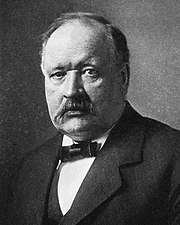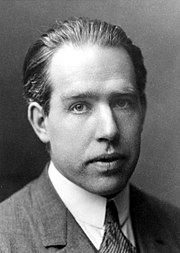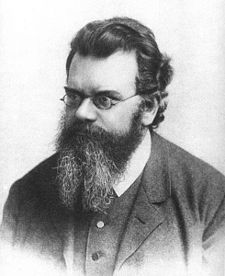Arrhenius was born on February 19, 1859 at Vik (also spelled Wik or Wijk), near Uppsala, Sweden, the son of Svante Gustav and Carolina Thunberg Arrhenius. His father had been a land surveyor for Uppsala University, moving up to a supervisory position. At the age of three, Arrhenius taught himself to read without the encouragement of his parents, and by watching his father's addition of numbers in his account books, became an arithmetical prodigy. In later life, Arrhenius enjoyed using masses of data to discover mathematical relationships and laws.
At age 8, he entered the local cathedral school, starting in the fifth grade, distinguishing himself in physics and mathematics, and graduating as the youngest and most able student in 1876.
At the University of Uppsala, he was unsatisfied with the chief instructor of physics and the only faculty member who could have supervised him in chemistry, Per Teodor Cleve, so he left to study at the Physical Institute of the Swedish Academy of Sciences in Stockholm under the physicist Erik Edlund in 1881. His work focused on the conductivities of electrolytes. In 1884, based on this work, he submitted a 150-page dissertation on electrolytic conductivity to Uppsala for the doctorate. It did not impress the professors, like Per Teodor Cleve, and he received a fourth class degree, but upon his defence it was reclassified as third class. Later, extensions of this very work would earn him the Nobel Prize in Chemistry.
Read More...................
Amedeo Avogadro was born in Turin to a noble family of Piedmont, Italy.
He graduated in ecclesiastical law at the early age of 20 and began to practice. Soon after, he dedicated himself to physics and mathematics (then called positive philosophy), and in 1809 started teaching them at a liceo (high school) in Vercelli, where his family had property.
In 1811, he published an article with the title Essai d'une manière de déterminer les masses relatives des molécules élémentaires des corps, et les proportions selon lesquelles elles entrent dans ces combinaisons ("Essay on Determining the Relative Masses of the Elementary Molecules of Bodies and the Proportions by Which They Enter These Combinations"), which contains Avogadro's hypothesis. Avogadro submitted this essay to a French journal, De Lamétherie's Journal de Physique, de Chimie et d'Histoire naturelle (Journal of Physics, Chemistry and Natural History) so it was written in French, not Italian. (Note: In 1811, northern Italy was under the rule of the French Emperor Napoléon Bonaparte.)
In 1820, he became professor of physics at the University of Turin. After the downfall of Napoléon in 1815, northern Italy came under control of this kingdom.
He was active in the revolutionary movements of 1821 against the king of Sardinia (who became ruler of Piedmont with Turin as his capital). As a result, he lost his chair in 1823 (or the university officially declared, it was "very glad to allow this interesting scientist to take a rest from heavy teaching duties, in order to be able to give better attention to his researches")[citation needed].
Eventually, Charles Albert granted a Constitution (Statuto Albertino) in 1848. Well before this, Avogadro had been recalled to the university in Turin in 1833, where he taught for another twenty years.
Little is known about Avogadro's private life, which appears to have been sober and religious. He married Felicita Mazzé and had six children.
Some historians suggest that he sponsored some Sardinian revolutionaries, who were stopped by the announcement of Charles Albert's constitution.
Avogadro held posts dealing with statistics, meteorology, and weights and measures (he introduced the metric system into Piedmont) and was a member of the Royal Superior Council on Public Instruction.
In honor of Avogadro's contributions to molecular theory, the number of molecules in one mole was named Avogadro's number, NA or "Avogadro's constant". It is approximately 6.0221415 × 1023. Avogadro's number is used to compute the results of chemical reactions. It allows chemists to determine the exact amounts of substances produced in a given reaction.
Read More.............
Niels Henrik David Bohr (Danish pronunciation: [nels ˈb̥oɐ̯ˀ]; 7 October 1885 – 18 November 1962) was a Danish physicist who made foundational contributions to understanding atomic structure and quantum mechanics, for which he received the Nobel Prize in Physics in 1922. Bohr mentored and collaborated with many of the top physicists of the century at his institute in Copenhagen. He was part of a team of physicists working on the Manhattan Project. Bohr married Margrethe Nørlund in 1912, and one of their sons, Aage Bohr, grew up to be an important physicist who in 1975 also received the Nobel prize. Bohr has been described as one of the most influential physicists of the 20th century.
Read More...........
Ludwig Eduard Boltzmann (February 20, 1844 – September 5, 1906) was an Austrian physicist famous for his founding contributions in the fields of statistical mechanics and statistical thermodynamics. He was one of the most important advocates for atomic theory when that scientific model was still highly controversial.
Read More...............
Pages
Blog Archive
-
▼
2010
(11)
-
▼
April
(11)
- NEW INDIAN RESEARCH CENTER IN ANTARCTICA
- NANO TECHNOLOGY CENTRES IN INDIA
- STEM CELL BANKING IN INDIA
- FIRST HUMAN GENOME SEQUENCING IN INDIA
- VERTICAL-LAUNCH VERSION OF BRAHMOS TEST-FIRED SUCC...
- INDIA TEST FIRES NUKE CAPABLE PRITHVI-II AND DHANU...
- NASA LAUNCHES LATEST HIGH-TECH WEATHER SATELLITE
- MOVING TOWARDS ‘THE GOD PARTICLE’ AT LHC
- LHC RESEARCH PROGRAMME GETS UNDERWAY
- Famous Chemists
- Famous Chemists
-
▼
April
(11)
About Me
Followers
2010 - CHEMGENE is proudly powered by Blogger
Blogger Template created by Anshul
Design By Templatelite.com
Blogger Template created by Anshul
Design By Templatelite.com




0 comments:
Post a Comment